This animation highlights the USGS Integrated Water Availability Assessments (IWAAs) Program’s evolving capacity to estimate water availability at a national scale by visualizing daily estimates of natural water storage (water present on the landscape such as standing water, snowpack, soil water, and shallow groundwater) for approximately 110,000 regions across the
Interactive Data Visualizations
Multi-figure, interactive data visualization to illuminate challenging concepts related to water use around the U.S. in 2015
Bayesian Modeling With High-Throughput Computing
The first national assessment of many-day time series of metabolic rates created using high-throughput computing to reduce model run-time.
Data Pipelines
Enhancing scientific research with reproducible, collaborative, and scalable data analysis workflows and methodologies.
Data scientists in the USGS Water Resources Mission Area make sense of large environmental and operational datasets by applying various modeling, statistical, and visualization techniques to generate actionable information.
Technological advances are driving exponential growth in data, improving the efficiency of many sectors and disrupting others. Extracting meaningful information quickly from the modern-day deluge of data is now a requirement for being successful. However, generating decision-ready data or predicting future outcomes from environmental or operational data is challenging and requires specialized skills. Research teams can tap into big data insights through the inclusion of data scientists — individuals with interdisciplinary backgrounds that include data analysis, statistics, data visualization, computer science, and mathematics.
At the USGS, water data science is focused on the following:
Modeling: Combine theory-based models with powerful empirical predictive tools (e.g., deep learning)
Data pipelines: Build efficiency through reproducible and collaborative data workflows
Data visualizations: Share insights with innovative and thoughtful visualizations
USGS has a rich history in the development and application of process-based models. These models are formulated based on known environmental relationships and are the de facto tool for water resources predictions. Alternatively, new deep learning (DL; a subset of machine learning) tools deliver improved prediction accuracy by resolving complex relationships in large quantities of data, and have great potential to aid scientific discovery for water resources. Theory-Guided Data Science modeling (figure 1; Karpatne et al. 2017) integrates process understanding into advanced machine learning modeling techniques. Data science collaborations with computer scientists at the University of Minnesota (V Kumar) and Virginia Tech (A Karpatne) are building and testing these hybrid modeling frameworks on water predictions.
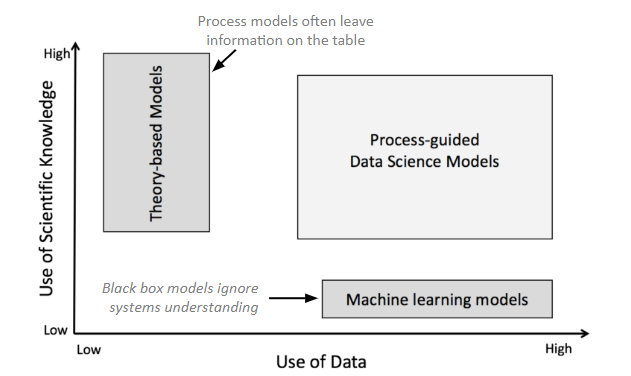
In addition to new modeling development, there is a growing emphasis on interdisciplinary research that necessitates integration of large, disparate datasets. Scientific workflows and computing methods must continually evolve to meet these challenges; however, current techniques for accessing and using data are not sufficient. Data scientists at the USGS develop and build tools that enable reproducible and collaborative data workflows (figure 2) and collaborate on research projects to assist on the challenges of data integration.
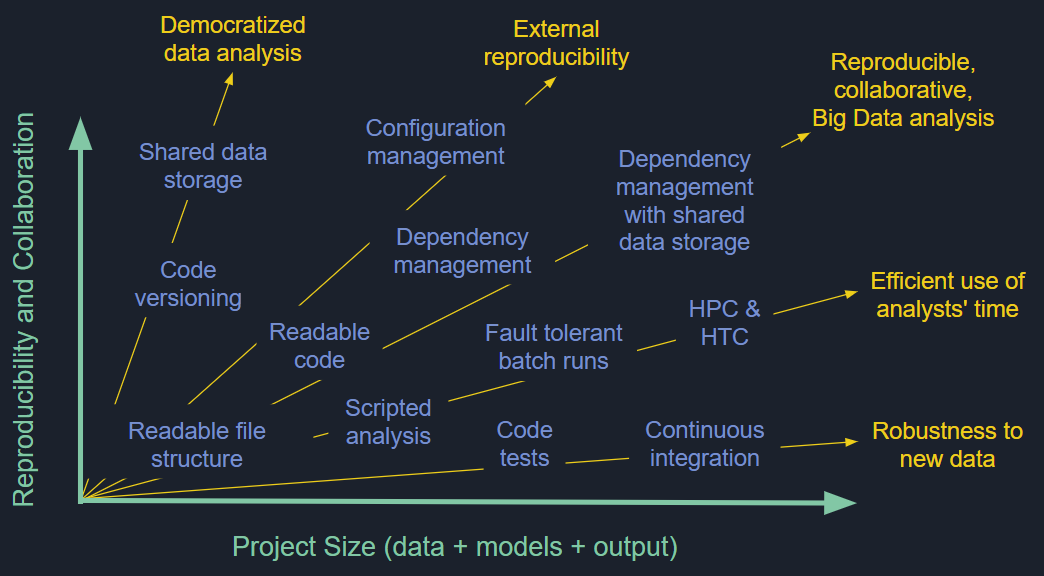
Beyond traditional scientific research, operational data and web analytics are important applications of data science in the USGS WMA. The primary platform for communicating with stakeholders, taxpayers, and Congress is the Web. Web products can be improved based on learning more about user behavior and user needs by capturing and analyzing website interactions. Data scientists are applying data science methods to operational data (figure 3) to help optimize web product development and improve the likelihood that stakeholders will find and use our products.
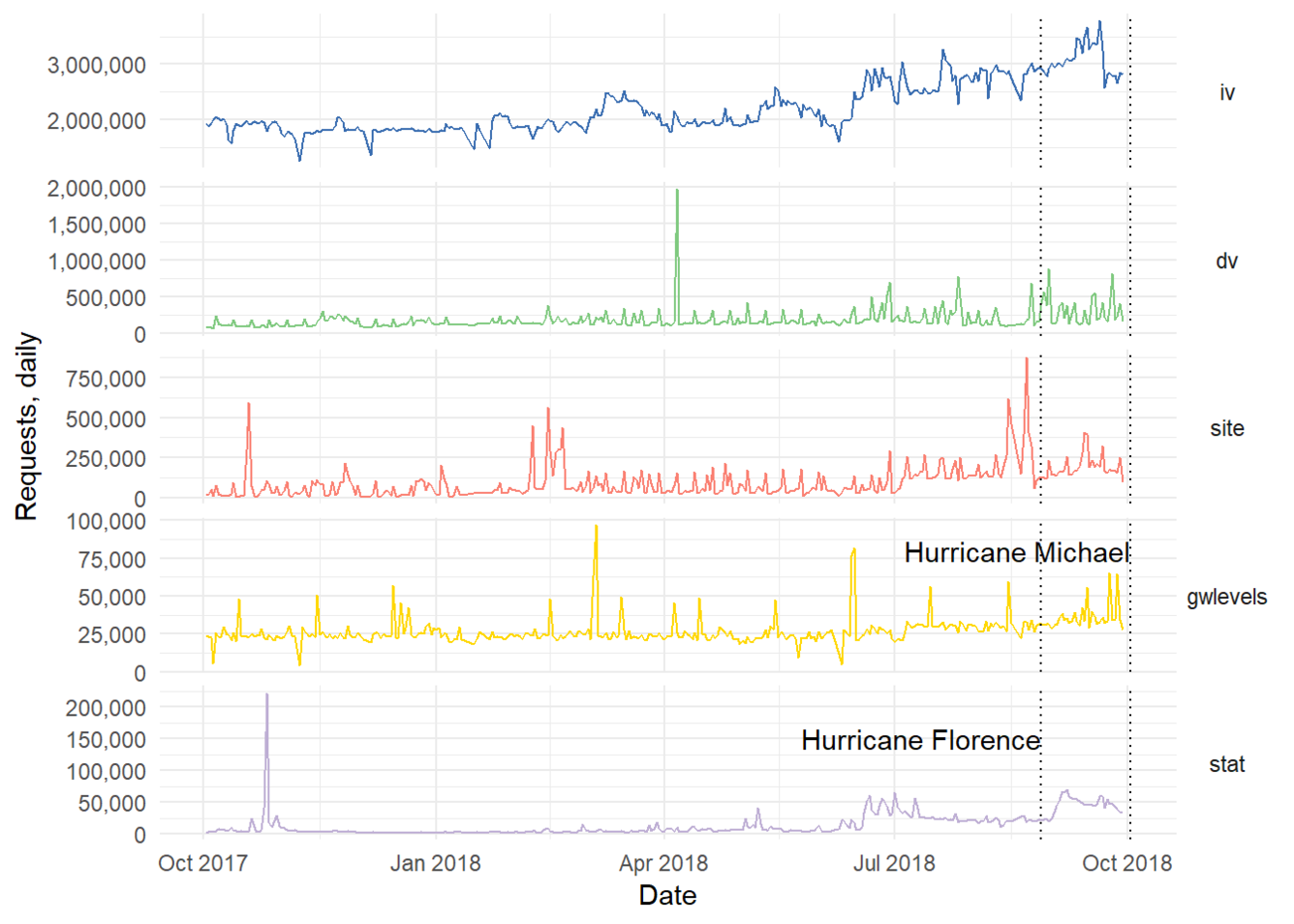
Data visualization is a valuable tool for making high-volume, complex data accessible to stakeholders, policy makers, and managers to facilitate data-driven conversations about environmental issues. While scientists are adept at creating graphs and figures that display scientific data and results, data science can strengthen scientific visual products and expand their reach to more diverse audiences (figure 4). See examples of USGS data visualizations here.
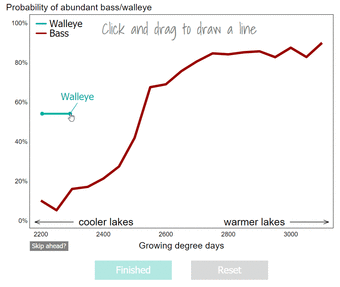
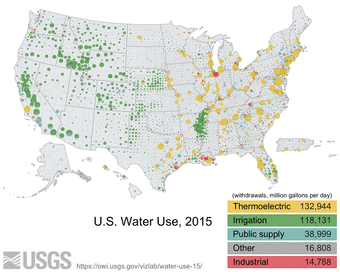
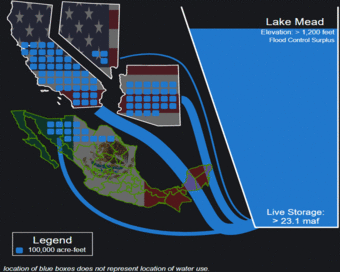
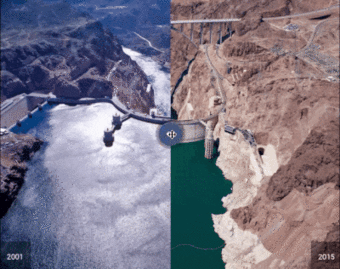
Figure 4. Collection of visualizations that take complex data and make them accessible to non-scientific audiences.
Want to learn more about data science at the USGS Water Resources Mission Area? Contact water-data-science@usgs.gov, explore related publications, data and tools, visualizations, or view relevant posts on the USGS water data blog.
Below are other science projects associated with water data science.
Exploring the USGS Science Data Life Cycle in the Cloud
Flocks of a feather dock together: Using Docker and HTCondor to link high-throughput computing across the USGS
Below are data or web applications associated with water data science.
U.S. Water Use from 1950-2015
National Water Information System web interface (NWISweb)
Below are multimedia items associated with water data science.

This animation highlights the USGS Integrated Water Availability Assessments (IWAAs) Program’s evolving capacity to estimate water availability at a national scale by visualizing daily estimates of natural water storage (water present on the landscape such as standing water, snowpack, soil water, and shallow groundwater) for approximately 110,000 regions across the
Data visualization pulling together multiple datasets from multiple agencies to explain how rain and flooding from Hurricane Florence impacted the landscape.
Data visualization pulling together multiple datasets from multiple agencies to explain how rain and flooding from Hurricane Florence impacted the landscape.
Below are publications associated with water data science.
The metabolic regimes of 356 rivers in the United States
Water quality data for national-scale aquatic research: The Water Quality Portal
Below are data or web applications associated with water data science.
Water Quality Portal
Hurricane Maria's Water Footprint
Hurricane Irma's Water Footprint
Hurricane Harvey's Water Footprint
Hurricane Matthew's Water Footprint
Microplastics in our Nation's Waterways
Drought in the Colorado River Basin - Insights Using Open Data
California Drought, Visualized with Open Data
Data scientists in the USGS Water Resources Mission Area make sense of large environmental and operational datasets by applying various modeling, statistical, and visualization techniques to generate actionable information.
Technological advances are driving exponential growth in data, improving the efficiency of many sectors and disrupting others. Extracting meaningful information quickly from the modern-day deluge of data is now a requirement for being successful. However, generating decision-ready data or predicting future outcomes from environmental or operational data is challenging and requires specialized skills. Research teams can tap into big data insights through the inclusion of data scientists — individuals with interdisciplinary backgrounds that include data analysis, statistics, data visualization, computer science, and mathematics.
At the USGS, water data science is focused on the following:
Modeling: Combine theory-based models with powerful empirical predictive tools (e.g., deep learning)
Data pipelines: Build efficiency through reproducible and collaborative data workflows
Data visualizations: Share insights with innovative and thoughtful visualizations
USGS has a rich history in the development and application of process-based models. These models are formulated based on known environmental relationships and are the de facto tool for water resources predictions. Alternatively, new deep learning (DL; a subset of machine learning) tools deliver improved prediction accuracy by resolving complex relationships in large quantities of data, and have great potential to aid scientific discovery for water resources. Theory-Guided Data Science modeling (figure 1; Karpatne et al. 2017) integrates process understanding into advanced machine learning modeling techniques. Data science collaborations with computer scientists at the University of Minnesota (V Kumar) and Virginia Tech (A Karpatne) are building and testing these hybrid modeling frameworks on water predictions.

In addition to new modeling development, there is a growing emphasis on interdisciplinary research that necessitates integration of large, disparate datasets. Scientific workflows and computing methods must continually evolve to meet these challenges; however, current techniques for accessing and using data are not sufficient. Data scientists at the USGS develop and build tools that enable reproducible and collaborative data workflows (figure 2) and collaborate on research projects to assist on the challenges of data integration.

Beyond traditional scientific research, operational data and web analytics are important applications of data science in the USGS WMA. The primary platform for communicating with stakeholders, taxpayers, and Congress is the Web. Web products can be improved based on learning more about user behavior and user needs by capturing and analyzing website interactions. Data scientists are applying data science methods to operational data (figure 3) to help optimize web product development and improve the likelihood that stakeholders will find and use our products.

Data visualization is a valuable tool for making high-volume, complex data accessible to stakeholders, policy makers, and managers to facilitate data-driven conversations about environmental issues. While scientists are adept at creating graphs and figures that display scientific data and results, data science can strengthen scientific visual products and expand their reach to more diverse audiences (figure 4). See examples of USGS data visualizations here.




Figure 4. Collection of visualizations that take complex data and make them accessible to non-scientific audiences.
Want to learn more about data science at the USGS Water Resources Mission Area? Contact water-data-science@usgs.gov, explore related publications, data and tools, visualizations, or view relevant posts on the USGS water data blog.
Below are other science projects associated with water data science.
Exploring the USGS Science Data Life Cycle in the Cloud
Flocks of a feather dock together: Using Docker and HTCondor to link high-throughput computing across the USGS
Below are data or web applications associated with water data science.
U.S. Water Use from 1950-2015
National Water Information System web interface (NWISweb)
Below are multimedia items associated with water data science.

This animation highlights the USGS Integrated Water Availability Assessments (IWAAs) Program’s evolving capacity to estimate water availability at a national scale by visualizing daily estimates of natural water storage (water present on the landscape such as standing water, snowpack, soil water, and shallow groundwater) for approximately 110,000 regions across the
This animation highlights the USGS Integrated Water Availability Assessments (IWAAs) Program’s evolving capacity to estimate water availability at a national scale by visualizing daily estimates of natural water storage (water present on the landscape such as standing water, snowpack, soil water, and shallow groundwater) for approximately 110,000 regions across the
Data visualization pulling together multiple datasets from multiple agencies to explain how rain and flooding from Hurricane Florence impacted the landscape.
Data visualization pulling together multiple datasets from multiple agencies to explain how rain and flooding from Hurricane Florence impacted the landscape.
Below are publications associated with water data science.
The metabolic regimes of 356 rivers in the United States
Water quality data for national-scale aquatic research: The Water Quality Portal
Below are data or web applications associated with water data science.



